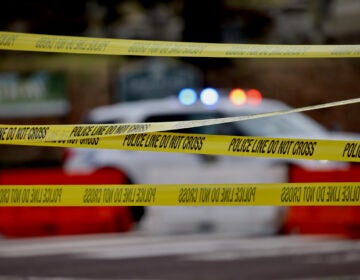Capt. Glenn on the mend, recalls hit-and-run accident
Four blocks from his office and halfway through a weekend night shift, Captain Stephen Glenn sat at a red light.
Illuminated both by traffic signal and the ambient fluorescence of a Hess Mart at Hunting Park Avenue and Clarissa Street, Glenn was behind the wheel of an unmarked 2009 Chevrolet Impala. He was preparing to turn left onto 18th Street when a driver pulled up alongside him. “This fella was really rocking his radio,” Capt. Glenn recalled, noting that “the bass was really driving. It kind of got into my shirt –I could feel my heart pulsing with the beat.”
“It’s a little bit disconcerting,” he adds.
“So I put on my flashing police lights – the emergency lights – and I rolled down my window. And, of course, the flashing lights caught his attention. He looked over – I had my interior light on, so he saw my uniform – and I say to him, ‘Can you turn that down? You’re going to wake the dead.’ He goes, ‘Oh, absolutely officer,’ and he reached over to turn the radio down, and it’s then that – bang! – I was struck from the rear. And the first thought I had was, ‘what did he do?'”
As previously reported by Newsworks, on Sunday, July 31 at approximately 3:30 am, Captain Stephen Glenn, Commanding Officer of Philadelphia’s 39th Police District – which covers Germantown, East Falls, Nicetown/Tioga and parts of North Philadelphia – was involved in a hit-and-run accident while on routine patrol. Sustaining an injury to his left leg, he was taken to Temple University Hospital where he was treated for a broken fibula. One month later, he remains on limited duty.
Recalling the collision, Capt. Glenn remembers being fixated on the driver alongside of him immediately after the crash. “I associated his movement to the dashboard and for a spilt second, I thought he had something in that car, and that he made [the impact] happen.” Recognizing this as unlikely, Glenn looked in his rear-view mirror and – seeing “the face of a fella that was way too close’ – realized that he had been rear-ended by another vehicle.
He then stepped out of the vehicle, only to notice that his left leg wasn’t functioning properly.
Assessing his injury, he thought to himself, “This can’t be good,” and reached inside the sedan for his police radio. As he attempted to locate it – the radio was knocked under the seat during the collision – the situation took a criminal turn.
Catching sight of the offending vehicle reversing and positioning for an eastbound escape, Glenn got back in his Impala and attempted pursuit.
He made it 90-yards.
“The rear wheels of my car were locked on the damage to the rear – they were dragging on the frame,” said Glenn, appraising his vehicle’s condition. Unable to give chase to a fleeing vehicle exiting the scene at 60 miles-per-hour, he returned to the intersection to safeguard debris on the road and wait for assistance.
A few more weeks of bruising, swelling and vascular issues
Fortunately for Captain Glenn, his injuries were not life-threatening. In fact, were it not for the steering-column adjustment bar that injured his leg, he might have left the accident unscathed.
“I was restrained,” said Glenn, referencing his seat belt, “so there were no injuries to my trunk or head.”
Nevertheless, emergency personnel from Medic 4B – stationed in the same building as the 39th district Headquarters – insisted on immobilizing Captain Glenn, bracing his neck and placing him on a backboard for transport to Temple University Hospital.
“They were apologizing for not being able to amputate my leg right then and there,” joked Glenn.
After his arrival at Temple, Glenn was told by doctors that his left fibular shaft had been broken. “They described it as being the least consequential bone in my leg,” said Glenn, “and that it didn’t need a cast.” Instead, he was given a walking boot, which he was relieved of in a few days.
“The only real issue has been bruising, swelling, and vascular issues – they said in a few weeks it would well be over,” he said.
In fact, so insignificant was his assessment of his maladies that he demurred to inform his wife.
“I have a lovely wife, and I knew at that time of night I knew she would be asleep. Since it was not a serious injury,” he said, “I declined to have her notified.”
“If anyone was going to notify her, it was going to be me. I waited until a respectful hour.”
Captain Glenn and his wife, Mary, are communicants of Saint Katherine of Siena in Torresdale. He said his wife serves as lector at 8 a.m. Sunday mass, “so I knew she was going to be up early.”
This was not Captain Glenn’s first injury in the line of duty. In 1986, as a sergeant in the Northwest Detective Division, Glenn required medical aid after assisting in the capture of an escaped prisoner.
Referencing the episode, Glenn recalls hearing a strange sound emanating from the ceiling. He proceeded to investigate the disturbance, only to discover the legs of a would-be fugitive dangling from above.
“The poor guy was holding on to this panel – a metal portion of the lighting,” Glenn remembers, “which he was using to pull himself up to the ceiling.”
“I grabbed his legs, and when he let go of the panel to pull himself up into the ceiling, it sliced me across the eyebrows.”
“I needed a few stitches,” he laughs. This time, the treatment is considerably less invasive – antibiotics and painkillers, the latter of which, Glenn is pleased to note, haven’t been needed.
Line of duty accident statistics
Whether through carelessness or malevolence, cars are a major source of concern for cops. According to statistics maintained by the Officer Down Memorial Page website, 45 of the 254 recorded line of duty deaths in PPD history are directly attributable to automotive misadventure, second only to gunfire.
The two most recent incidents occurred in 2008, when both Sgt. Timothy Simpson and PO Isabel Nazario died as a result of vehicular assaults.
Nationwide, of the 129 law enforcement fatalities recorded to date in 2011, 46 are linked to traffic incidents, as posted by the National Law Enforcement Officers Memorial Fund.
The NLEOMF website indicates that traffic fatalities were, for the thirteenth consecutive year, the leading cause of law enforcement deaths in 2010, with 73 killed in the line of duty.
This represents a 43-percent increase from 2009.
So prevalent are traffic-related injuries and fatalities that in 2009, the National Institute for Occupational Safety and Health – a subsidiary of the Centers for Disease Control –adopted a strategic goal, as part of its National Public Safety Agenda, to reduce traumatic injuries and fatalities resulting from vehicle collisions involving law enforcement personnel by 15-percent before 2015.
However, line-of-duty injuries aren’t solely the province of the rank-and-file. According to the Bureau of Labor Statistics, law enforcement supervisory personnel are subject to a significantly greater occurrence of transportation-related harms.
BLS data from 2009 indicates that there was a non-fatal highway accident incidence rate of 35.4 (per 10,000) for supervisory and management personnel –defined as ranks at or above sergeant– in the protective services, as opposed to a rate of 23.1 for all protective services.
When compared to an injury rate of 3.7 for all occupations, these statistics underscore the dangers inherent in policing at any rank.
Fighting for tougher penalties
Hit-and-run accidents – and their consequences – have attracted considerable media attention recently, due in part by efforts from local legislators. State Sen. Larry Farnese, of Pennsylvania’s 1st Senatorial District, introduced legislation last year that increases grading and penalties to the perpetrators of hit-and-run accidents.
Cathie Abookire, Farnese’s Director of Communications, said that Senate Bills 1267 and 1268 would upgrade hit-and-run offenses from misdemeanors to third-degree felonies.
In addition, the proposed bills would stiffen penalties to those who commit vehicular offenses upon Emergency Service Responders – ESR’s – such as Captain Glenn.
Abookire explained that in the case of Bill 1268, if the prosecution demonstrates that the offense occurred while an ESR was responding, it will add another two years to the sentence.
Referring to Captain’s Glenn’s accident – which she termed as being “especially egregious” – Abookire stated that under the proposals called forth by Farnese, “this would be a felony in the third degree, which would result in a maximum sentence of seven years. As it occurred with an ESR, (the perpetrator) would face a maximum of 9 years.”
At present, the accident remains under investigation and the suspect remains at large. Despite Glenn’s valiant attempt to pursue him, the offender – described as being an African-American male, 35-40, wearing dark-rimmed glasses and driving a reddish-rust Pontiac, Buick, or Oldsmobile – has yet to be caught.
“Ordinarily, on Hunting Park Avenue, there’s a police officer either coming from or going to the district,” says Glenn. “It’s the old cliché, there’s never a policeman when you want one,” he adds, “but on that night, had there been one, the fella would have been apprehended.”
“His fortune, my misfortune,” surmised Glenn, “but we live to fight another day.”
WHYY is your source for fact-based, in-depth journalism and information. As a nonprofit organization, we rely on financial support from readers like you. Please give today.




